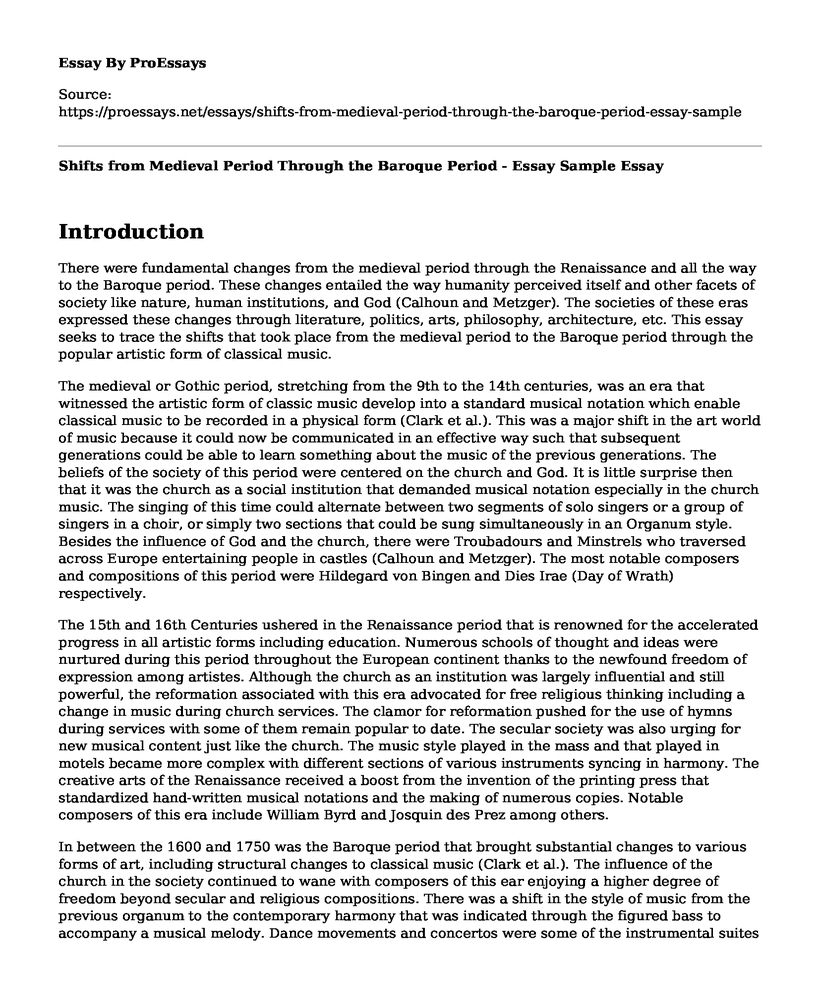Introduction
There were fundamental changes from the medieval period through the Renaissance and all the way to the Baroque period. These changes entailed the way humanity perceived itself and other facets of society like nature, human institutions, and God (Calhoun and Metzger). The societies of these eras expressed these changes through literature, politics, arts, philosophy, architecture, etc. This essay seeks to trace the shifts that took place from the medieval period to the Baroque period through the popular artistic form of classical music.
The medieval or Gothic period, stretching from the 9th to the 14th centuries, was an era that witnessed the artistic form of classic music develop into a standard musical notation which enable classical music to be recorded in a physical form (Clark et al.). This was a major shift in the art world of music because it could now be communicated in an effective way such that subsequent generations could be able to learn something about the music of the previous generations. The beliefs of the society of this period were centered on the church and God. It is little surprise then that it was the church as a social institution that demanded musical notation especially in the church music. The singing of this time could alternate between two segments of solo singers or a group of singers in a choir, or simply two sections that could be sung simultaneously in an Organum style. Besides the influence of God and the church, there were Troubadours and Minstrels who traversed across Europe entertaining people in castles (Calhoun and Metzger). The most notable composers and compositions of this period were Hildegard von Bingen and Dies Irae (Day of Wrath) respectively.
The 15th and 16th Centuries ushered in the Renaissance period that is renowned for the accelerated progress in all artistic forms including education. Numerous schools of thought and ideas were nurtured during this period throughout the European continent thanks to the newfound freedom of expression among artistes. Although the church as an institution was largely influential and still powerful, the reformation associated with this era advocated for free religious thinking including a change in music during church services. The clamor for reformation pushed for the use of hymns during services with some of them remain popular to date. The secular society was also urging for new musical content just like the church. The music style played in the mass and that played in motels became more complex with different sections of various instruments syncing in harmony. The creative arts of the Renaissance received a boost from the invention of the printing press that standardized hand-written musical notations and the making of numerous copies. Notable composers of this era include William Byrd and Josquin des Prez among others.
In between the 1600 and 1750 was the Baroque period that brought substantial changes to various forms of art, including structural changes to classical music (Clark et al.). The influence of the church in the society continued to wane with composers of this ear enjoying a higher degree of freedom beyond secular and religious compositions. There was a shift in the style of music from the previous organum to the contemporary harmony that was indicated through the figured bass to accompany a musical melody. Dance movements and concertos were some of the instrumental suites that laid the foundation for modern classical forms. George Frideric Handel, George Phillip Telemann, Henry Purcell, Arcangelo Corelli, and Domenico Scarlatti among others were some of the iconic composers of the Baroque era classical music.
Works Cited
Calhoun, Jimi, and Paul L. Metzger. The Art of God: Reflections on Music, Diversity, and the Beauty in You. Eugene, Oregon: Cascade Books, 2015. Print.
Clark, N. A. et al. Understanding Music: Past and Present. Dahlonega, Georgia: University of North Georgia Press, 2016. Internet resource.
Cite this page
Shifts from Medieval Period Through the Baroque Period - Essay Sample. (2022, Aug 08). Retrieved from https://proessays.net/essays/shifts-from-medieval-period-through-the-baroque-period-essay-sample
If you are the original author of this essay and no longer wish to have it published on the ProEssays website, please click below to request its removal:
- Do the Right Thing Film Analysis Essay
- Heartbeat Ensemble Essay Example
- Debussy: Sonata for Cello and Piano Essay
- Essay Sample on The Reason I Should care about movies
- Essay Example on Benito Mussolini: Fascist Rule and World Politics
- Paper Sample on Digital Marketing: Potential Branding Opportunities Through Social Media
- Free Paper Sample: Impact of the Bilbao Effect







